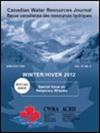Standardized precipitation evapotranspiration index (SPEI) for Canada: assessment of probability distributions
IF 1.7
4区 环境科学与生态学
Q3 WATER RESOURCES
引用次数: 0
Abstract
Abstract Candidate probability distributions for the Standardized Precipitation Evapotranspiration Index (SPEI) for Canada were examined using the Canadian Gridded (CANGRD) temperature and precipitation dataset and CMIP5 projections. The probability distribution is a core component to the calculation of standardized values. For SPEI, a continuous probability distribution is fitted to the water balance time series so that the resulting transformed index follows a standard normal distribution. Selection of an appropriate distribution is therefore important as an inappropriate distribution may lead to biased values and subsequently affect the interpretation of SPEI results. Candidate distributions considered for SPEI included the generalized logistic (GLO), generalized extreme value (GEV), Pearson Type III (PE3) and normal (NOR) distributions. A range of goodness of fit tests were used to assess how well the distributions fit SPEI. Differences in CANGRD SPEI time series between three pairs of distributions, GLO-GEV, GLO-PE3, and GEV-PE3, showed that there were larger differences in SPEI values between GLO and the other two distributions than the difference between GEV and PE3. SPEI results fitted with GLO resulted in lower threshold exceedances of extreme SPEI (-/+2) than GEV and GLO. A comparison between CMIP5 SPEI values fitted with GLO (SPEI-GLO) and PE3 (SPEI-PE3) showed that there were seasonal and spatial variations in results, although the use of multi-model ensembles reduced these differences. As was the case for CMIP5 SPEI-GLO projections, projected annual changes in CMIP5 SPEI-PE3 show an increase in drying at the surface in central/southern Canada. Overall, the study recommends using PE3 or GEV for SPEI analysis for Canada.加拿大标准化降水蒸散指数:概率分布的评估
利用加拿大网格(CANGRD)温度和降水数据集和CMIP5预估,对加拿大标准化降水蒸散发指数(SPEI)的候选概率分布进行了研究。概率分布是标准化数值计算的核心组成部分。对于SPEI,将水平衡时间序列拟合为连续概率分布,使变换后的指标服从标准正态分布。因此,选择一个合适的分布是很重要的,因为一个不合适的分布可能导致偏差值,并随后影响对SPEI结果的解释。SPEI考虑的候选分布包括广义logistic (GLO)、广义极值(GEV)、Pearson III型(PE3)和正态(NOR)分布。使用一系列拟合优度检验来评估分布与SPEI的拟合程度。GLO-GEV、GLO-PE3和GEV-PE3三对分布之间的CANGRD SPEI时间序列差异表明,GLO与其他两个分布之间的SPEI值差异大于GEV与PE3之间的差异。与GLO拟合的SPEI结果相比,GEV和GLO的SPEI极端值(-/+2)超出阈值较低。对GLO (SPEI-GLO)和PE3 (SPEI-PE3)拟合的CMIP5 SPEI值进行比较发现,结果存在季节和空间差异,但多模式组合的使用降低了这些差异。与CMIP5 SPEI-GLO预估的情况一样,CMIP5 SPEI-PE3预估的年变化显示加拿大中部/南部地表干燥程度增加。总的来说,该研究建议使用PE3或GEV进行加拿大的SPEI分析。
本文章由计算机程序翻译,如有差异,请以英文原文为准。
求助全文
约1分钟内获得全文
求助全文
来源期刊

Canadian Water Resources Journal
WATER RESOURCES-
CiteScore
2.90
自引率
5.90%
发文量
17
审稿时长
>12 weeks
期刊介绍:
The Canadian Water Resources Journal accepts manuscripts in English or French and publishes abstracts in both official languages. Preference is given to manuscripts focusing on science and policy aspects of Canadian water management. Specifically, manuscripts should stimulate public awareness and understanding of Canada''s water resources, encourage recognition of the high priority of water as a resource, and provide new or increased knowledge on some aspect of Canada''s water.
The Canadian Water Resources Journal was first published in the fall of 1976 and it has grown in stature to be recognized as a quality and important publication in the water resources field.
 求助内容:
求助内容: 应助结果提醒方式:
应助结果提醒方式:


